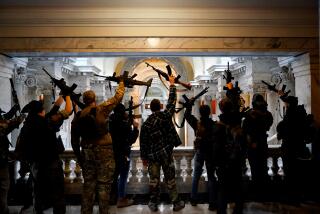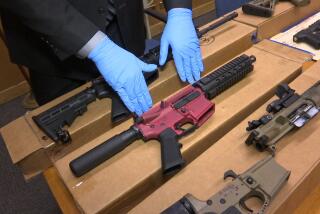Study takes new look at gun access and risk of homicide, suicide
- Share via
People who have ready access to a firearm are almost twice as likely to be killed and three times likelier to commit suicide than those without a gun available in the home or from a neighbor or friend, a new study has concluded.
Though men and women with firearm access were about equally likely to take their own lives with a gun, the latest research turned up a gender gap when it came to homicide. Compared with all adults without access to a gun, men with firearm access were 29% more likely to die in a gun-related homicide. But the analysis found that a woman who had a gun in or available to her household was close to three times likelier to die by homicide.
Previous studies have found that three-quarters of women who are killed with a gun die in their home, and that women typically know their assailant. That suggests that women who live in homes with a firearm are more likely to be gunned down in a domestic dispute or by an abusive partner, the research team wrote in their study, published Monday in Annals of Internal Medicine. But the group did not venture an explanation for why men with gun access were not much more vulnerable than other adults.
The United States is thought to have the highest rate of gun ownership of any country, with close to 4 in 10 households owning a firearm. The nation’s gun-related homicide rate is higher than that of any other high-income country, and its rate of suicides carried out with a gun exceeds that of any other country that maintains such data.
Many people cite those facts to argue that owning a gun is a household hazard. But gun rights advocates call that logic spurious and counter that by deterring threats, lawful gun ownership makes a household safer.
For the new study, epidemiologists from UC San Francisco combined and distilled the findings of existing studies of firearms-related injuries. While its conclusions were in line with a wealth of studies already in hand, they may provide a conservative estimate of the risk of gun-related death among those who own or have access to a firearm.
The analysis relied only on studies that started with a population of known gun-related homicide and suicide victims, then established whether and what kind of access to firearms those victims had and compared them to matched populations that had not died. In doing so, they sought to uncover whether a “true link between gun ownership and harms outcomes” could be drawn, they wrote.
Much of the research that has linked gun ownership to higher rates of gun-related victimization has looked at rates of gun-related injury in large populations — in cities, states and countries — and shown how they track with gun ownership.
The authors of the study, led by Andrew Anglemyer, sought to avoid the methodological pitfalls that have opened such studies to criticism. Gun rights advocates in particular have argued that population-wide studies overestimate the risks of gun ownership by failing to count firearms that are bought and sold illegally and, while rarely acknowledged by their owners, are often used in crimes. Even those who muster these findings in support of gun limits acknowledge they fail to draw a causal link between gun ownership and victimization.
The 14 studies considered by the UC San Francisco team were observational studies, and they could not make a causal link either. But at least they started with a dead victim and worked backward from there. That may be the best that can be done, experts said, since it’s unlikely anyone will ever conduct a clinical trial in which study participants are randomized to gun-owning households or non-gun-owning households and then tracked to see how many in each group die by a firearm.
Nine of the 14 studies were published in 1997 or later. That is after Congress passed a law prohibiting the U.S. Department of Health and Human Services from spending federal funds on research that could be interpreted as promoting or advocating for gun control measures.







